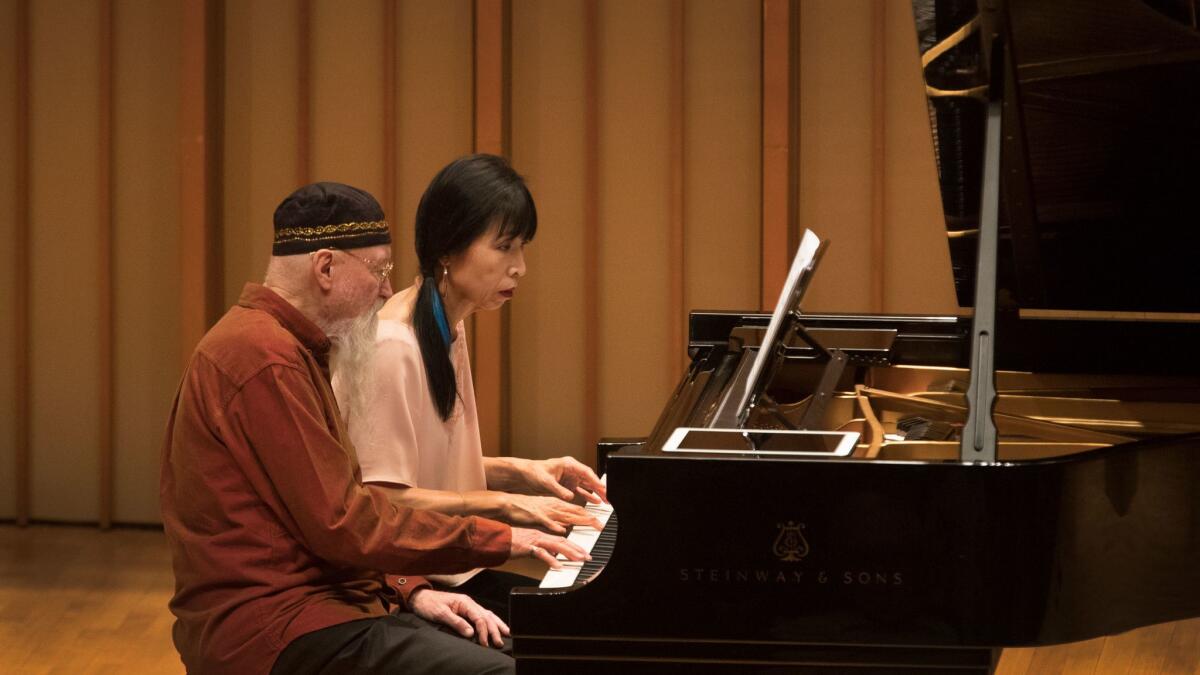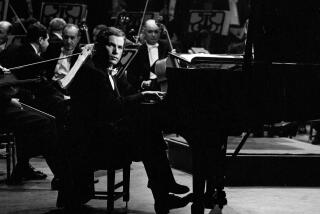Review: Terry Riley and Gloria Cheng, a piano odd couple, find the musical connections

It doesn’t take much effort to slot Terry Riley into music history. As part of the bustling experimental music scene in the Bay Area, he tossed off 53 short melodic phrases centered on C major, and instructed that they be repeated as many times as seemed suitable by members of any ensemble. He added a beat.
The rest is history. This was the birth of the Minimalist movement in music, still going strong more than half a century later. “In C” has become such a classic that even the Los Angeles Master Chorale will perform it on its May program.
Riley also demonstrated himself an inspired pianist, an improviser and a psychedelic groove-maker capable of playing mind-bending rhythmic patterns, sometimes in mind-blowing, all-night-long organ or electric keyboard recitals. Even as he evolved, consuming Indian raga or writing narrative string quartets for Kronos, there was also approachable method to his trance-inducing madness.
But the fact is, Riley is impossible to pigeonhole, as Gloria Cheng demonstrated in her illuminating all-Riley Piano Spheres concert Tuesday night at Zipper Concert Hall.
In the first half, Cheng surveyed Riley’s notated piano music, from his student days at UC Berkeley in the late 1950s to the early 1990s (of which there is surprisingly little). In the second half, Riley, now 82 and as stunning a pianist as ever, played three tributes to mentors. Together, Riley and Cheng then premiered “Cheng Tiger Growl Roar,” for piano four-hands and written for the occasion.
What, in fact, makes Riley special is that he has absorbed a vast stretch of different music styles, be they from the Western tradition — classical, jazz, folk, pop — or the East, particularly India, in radically different ways. He may focus on a single idea, but one that is, usually in a way too deep to discern, any number of different practices. Or he may focus on just one kind of music, but get waylaid somewhere along the line. Then again, he can just sit down at the piano and let the waylay happen.
In Riley’s vast musical brain, something in a piano rag might suggest a sequence for repetition or get him to start chanting a Carnatic song. The main point of Riley’s stupendous career has been suggestibility. He is classically trained (with an academic degree in composition and a couple decades of raga study), but his main education has been simply in the doing.
Cheng began with two of Riley’s student Two Pieces for Piano, written under the spell but not the technique of Schoenberg. The angular, disjointed, tightly knit atonal phrases might make the ecstatic rejoinder of tonality, pulse and improvisation in “In C,” written six years later, might seem like rebellion.
Cheng directed the audience to a rare recording, now found online, of Riley playing the early studies at his master’s recital in Berkeley. Fabulous pianist he was. But Cheng’s commanding performance went far further.
She exposed a natural sense of tonal connections that may not be analytically obvious. Instead, it was a sense of the way that fragments combine, one leading in some mysterious but right way to the other.
Riley didn’t write a fully notated piano piece, amazingly, for another 35 years. But when he finally did, in 1994, for Cheng and three other pianists, he produced, with “The Heaven Ladder, Book 7,” a masterpiece. Cheng gave the West Coast premiere of it on her first Piano Spheres recital and recorded it. This was, 24 years later, her first return to the full five-movement suite.
She and Riley appear an odd couple. Riley is about unpredictability. Cheng is a meticulous pianist who carefully unearths luminosity in all she plays. She doesn’t improvise. He, given half the chance, will do nothing but. Even Riley’s most carefully structured scores have the quality of inspired noodling captured for posterity. He is notorious for notation that leaves a great deal up to the performer, while actually wanting very specific things. In her notes, Cheng jokes that she and Riley originally disagreed on just about everything in her interpretation of “Heaven’s Ladder.”
Returning to it now, she makes it sound as seductive as anything by Ravel. The longest movement, a rapturous fandango that departs into more musical universes than I can keep track of but keeps coming back to Spain, is a wondrous journey. Riley’s instruction for the sublimely Satie-esque “Simone’s Lullaby,” written to put his granddaughter to sleep, is to repeat as long as it takes. Cheng found such beauty that you might want to listen all night.
Riley’s own improvised tributes — to his Indian mentor, Pandit Pran Nath, to his ragtime mentor, Wally Rose, and to Margaret Lyon, who enticed him to teach at Mills College in the 1970s — were worlds unto themselves. I sat in on Pran Nath’s classes at Mills, and Lyon was my beloved graduate adviser. I can’t tell you how or why or pretend objectivity, but Riley conjured them.
In “Cheng Tiger Growl Roar,” Cheng had a written-out score, and Riley improvised around it. There was some uncertainty, but there was also a delight in two different piano styles in tense but complementary conversation through modal scales, percussive bass notes, incandescent chords, moody blues riffs and titillating trills.
More to Read
The biggest entertainment stories
Get our big stories about Hollywood, film, television, music, arts, culture and more right in your inbox as soon as they publish.
You may occasionally receive promotional content from the Los Angeles Times.







